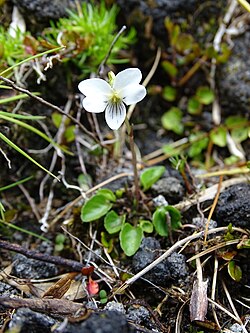Biology:Viola cunninghamii
| Viola cunninghamii | |
|---|---|

| |
| Scientific classification | |
| Kingdom: | Plantae |
| Clade: | Tracheophytes |
| Clade: | Angiosperms |
| Clade: | Eudicots |
| Clade: | Rosids |
| Order: | Malpighiales |
| Family: | Violaceae |
| Genus: | Viola |
| Species: | V. cunninghamii
|
| Binomial name | |
| Viola cunninghamii Hook.f.
| |
| Synonyms | |
|
List
| |
Viola cunninghamii, also known as the white mountain viola, is a species of flowering plant within the genus Viola and family Violaceae.[1]
Description
Viola cunninghamii is a perennial herb known for its slender and branching rhizome. The plant forms a cluster of leaves in a tufted rosette pattern. The leaf blades are generally triangular-ovate to sub-orbicular, measuring between 10 and 20 mm in diameter. The edges of the leaves have slightly indistinct, crenate margins, and their stalks are longer than the blade itself.[2]
The flowers of Viola cunninghamii emerge singularly on elongated stalks that surpass the length of the leaves. These delicate flowers showcase shades of white or pale violet, with a length of about 6 to 10 mm. Notably, the rear petal of the flower features a short, blunt spur. The flowering period typically occurs between the months of November and February. The fruit of this herb takes the form of a capsule that splits open into three valves when matured.[2] The species has a chromosome count of 2n = 48.[3]
When distinguishing Viola cunninghamii from other Viola species in Tasmania, certain defining characteristics of this species can be identified. The presence of rhizomes distinguishes it as a rhizomatous species. Additionally, the spurred anterior petal, rather than just a pouched one, sets it apart. Furthermore, the leaves of Viola cunninghamii are rounded, contrasting with the lanceolate or oblong leaves found in other similar species.[2]
Distribution and habitat
Viola cunninghamii possesses a widespread Oceanic distribution, where it can be found in New Zealand, Tasmania and the Chatham Islands.[4] The species inhabits elevated mountain habitats such as alpine herbfields, grasslands, and grassy heaths.[2]
References
- ↑ "Viola cunninghamii Hook.f.". 2021-06-01. https://collections.tepapa.govt.nz/object/1283437.
- ↑ 2.0 2.1 2.2 2.3 Rschahinger (2013-01-07). "Viola cunninghamii Threatened Flora of Tasmania". https://www.naturalvaluesatlas.tas.gov.au/downloadattachment?id=14621.
- ↑ "Viola cunninghamii". 2023-06-01. https://www.nzpcn.org.nz/flora/species/viola-cunninghamii/.
- ↑ "Viola cunninghamii Hook.f.". 2023-06-01. https://powo.science.kew.org/taxon/urn:lsid:ipni.org:names:867980-1.
Wikidata ☰ Q17563696 entry
 |

